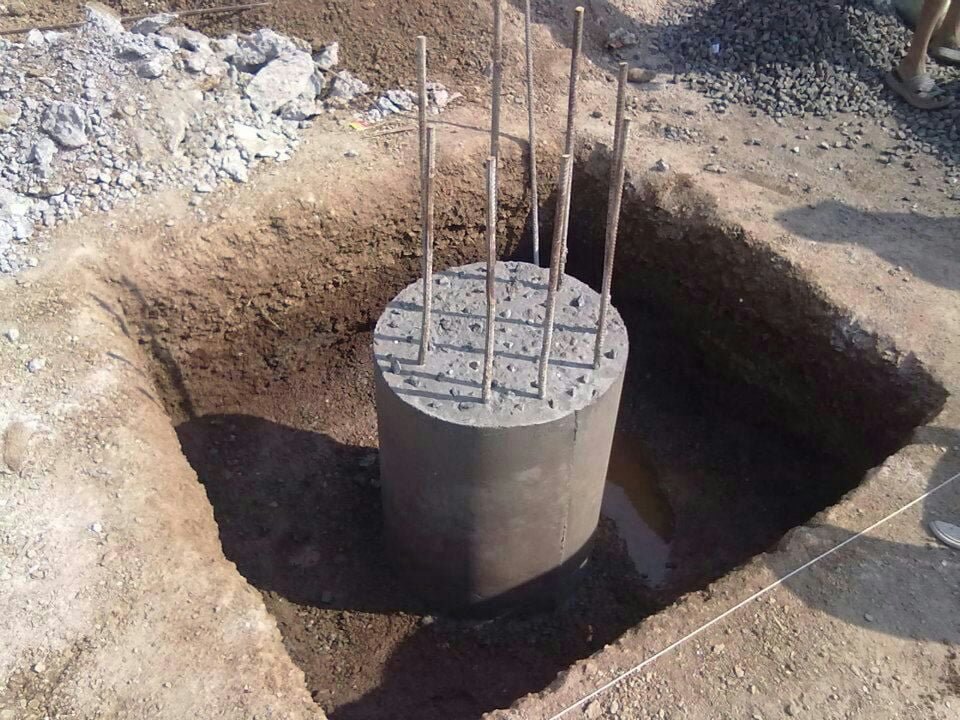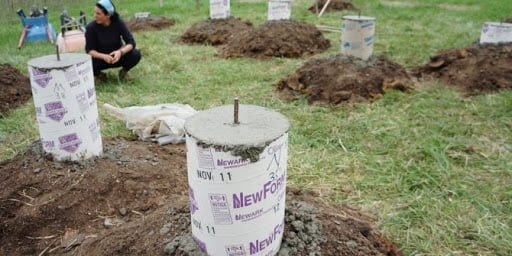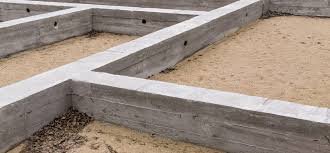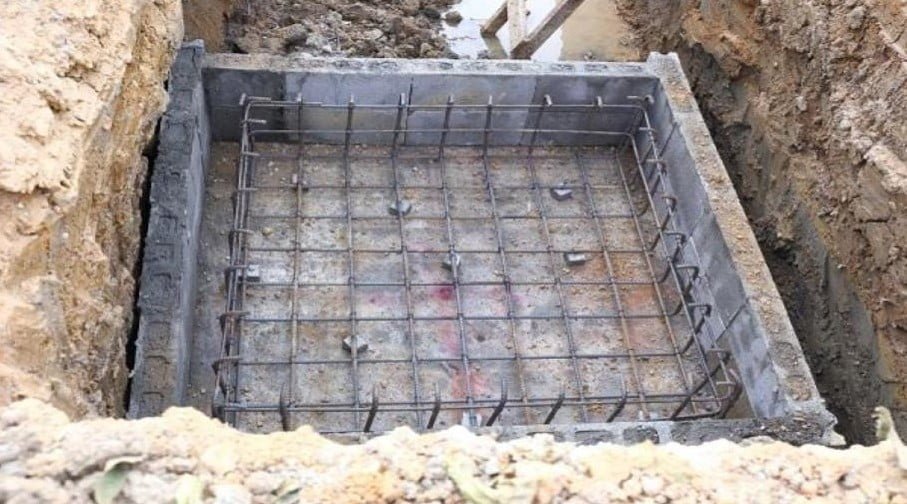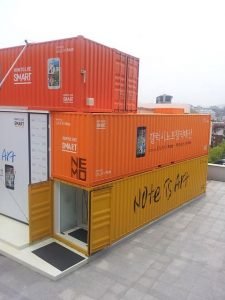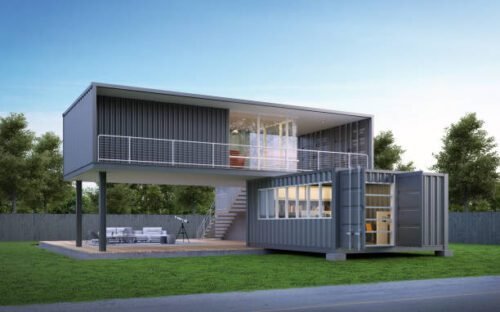Along with proper insulation, ensuring you use the right type of foundation for a container home is crucial for a successful construction.
We previously discussed how to build your container home correctly. Since this new article is a continuation of that discussion, if you haven’t done so already, you may want to take the time to read the other article before continuing here.
Do I Need a Foundation for My Containers?
In summary, you will always need a foundation for your container home. This is because the ground moves a lot. The ground can rise, sink, or slide. This movement can be sporadic and is often very slow. Although it’s often barely noticeable, this slight movement can affect your home’s level.
A foundation provides a solid and stable platform for your building. Without this solid platform, the natural movement of the ground can cause the containers to crack and separate.
The ground beneath your building can also be made up of different materials. For example, part of the ground could be hard rock, and the other part soft clay. This creates an uneven surface that can allow your home to move, as the load isn’t evenly distributed. One result could be incredibly difficult-to-open and close doors.
A solid, well-constructed foundation will ensure that the weight is properly distributed. It will also help prevent moisture and the resulting corrosion. Keep in mind that if the container home will be relocated within a few months, it’s sufficient to use railroad sleepers for this brief period.
Types of Foundations for Container Homes
The four main types of foundations that can be used with container homes are piers, piles, slabs, and strips. There are other types of foundations, but these are the most commonly used with container homes. We’ll describe when to use each one and discuss their strengths and weaknesses.
Pier Foundations
Pier foundations are the most popular choice for container homes for numerous reasons. They are relatively cost-effective, suitable for DIY work, and quick to build.
As seen in the image above, a pier’s base is composed of concrete blocks. Each concrete block, or pier, is typically 50 cm x 50 cm x 50 cm and reinforced with steel inside to enhance concrete strength in tension.
With container homes, concrete piers are generally placed at each corner of the container. And with larger 40-foot containers, two additional piers can be placed in the middle of each side of the container. Using pier foundations saves a lot of time and money because you don’t need to excavate much soil at all. You only need to dig the soil for the piers, which are generally 50 cm x 50 cm x 50 cm.
Compare this to a slab foundation where you would have to excavate basically the entire area under the container. Another great reason to use pier foundations is that other foundations, such as pile foundations, require expensive specialized equipment that can be challenging for DIY builders. This is by far the most popular container foundation and the one we recommend for most people.
Pile Foundations
Pile foundations are used when the soil type is too weak to support a concrete foundation. This type is the most expensive foundation covered here.
If you remember, pile foundations were used in the Graceville Container Home case study. Piles (solid steel cylindrical tubes) are driven into the ground through the soft soil until the piles reach a more suitable load-bearing soil.
Once the piles are secured in place, they are traditionally capped with a concrete block. So, once you’ve secured all your piles, you’ll end up with a grid system of concrete caps that, above ground, look visually similar to concrete piers.
Pile foundations are not recommended for inexperienced builders or for a DIY project. A contractor would be needed to install pile foundations due to the specialized equipment required, like a pile driver.
Slab Foundations
A slab foundation is a popular choice when the soil is soft and requires even weight distribution. However, it takes more time and is more expensive to build than a pier foundation. If you’re going to use a slab foundation, be prepared to do a lot of digging!
As shown in the image above, a slab foundation is a concrete slab on which the containers are placed. The slab foundation is generally slightly larger than the size of your home. If you’re building with two 40-foot containers, the slab foundation typically measures 18 feet wide by 42 feet long. This provides a one-foot overhang around the perimeter of your containers.
A great benefit of slab foundations is that, since they provide a solid base, there is no hollow space in the foundations. This prevents future issues like termite infestations. Unfortunately, due to the additional concrete used and the large amount of space that needs to be excavated, slab foundations are significantly more expensive than pier foundations.
We often see slab foundations used in warmer climates where freezing is not a concern. However, they increase the potential for heat loss when the ground temperature drops below the indoor temperature because the container can conduct heat to the ground, which transfers heat more than by convection to the air.
Keep in mind that with slab foundations, once the concrete has set, there’s no access to utility lines. If there’s a leak in the water pipe, you’ll need to cut the concrete to access the pipe. With a pier foundation, you’ll always have access to your utility lines.
Strip Foundations
A strip foundation (also known as a trench foundation) is a combination of the aforementioned pier and slab foundations. The strip foundation, shown below, is simply a strip of concrete placed to support the containers. The concrete strip is usually 1 to 2 feet wide and 4 feet deep.
The strip can surround the perimeter of the containers or can be placed at the top and bottom of the containers. It’s ideal for use when you’re looking for a cheaper alternative to a slab foundation but have slightly less firm ground to place the base on.
For places where the ground remains wet most of the time due to heavy rainfall, a rubble strip foundation can be used with loose stone beneath the concrete strip. This stone allows water to flow and drain.
Like all types of foundations mentioned, strip foundations also have their weaknesses. For instance, strip foundations have low earthquake resistance. Additionally, due to their shallow nature, strip foundations are best suited for small and medium-sized constructions.
Attaching Containers to Foundations
The most popular way to secure containers to the foundation platform is through a steel plate. The cast-in-place option involves pressing a steel plate with welded anchors into the wet concrete. You can also apply epoxy to the anchors in the concrete after it’s in place. While mechanical anchors can also be used, they are usually less strong and not recommended.
Either way, you’re looking for a flat and level concrete plate that matches the four corners of each container. Once the concrete has cured, the containers are placed on the steel plates, and everything can be welded together.
Some people choose to place containers directly on the foundations, where they are simply held in place by their immense weight. In most cases, this is probably fine, but you should be aware that floods and tornadoes can move a loose container!
Concrete Strength for Your Foundation
If you opt to use a concrete pier or slab foundation, this section is extremely important to read. Once people have decided to use a concrete foundation, the next question is typically what concrete strength to use.
The concrete strength you need to use for your foundation will be primarily determined by the geotechnical engineer’s report. Concrete strength will be denoted as the C value. C15 concrete, a general-purpose concrete, is made using:
- 1 part cement,
- 2 parts sand, and
- 5 parts gravel.
The higher the proportion of cement used, the stronger the concrete. For example, C30 is a very strong concrete composed of:
- 1 part cement,
- 2 parts sand, and
- 3 parts gravel.
If you’re mixing small quantities, you can do it by hand or with a cement mixer. For anything over 1 cubic meter, consider having the concrete delivered to your site, ready to use. Please note that if you’re mixing the concrete yourself, make sure to thoroughly mix all elements together properly; otherwise, the concrete strength is significantly reduced. To determine the amount of concrete you need, simply calculate the cubic meters of your foundation. Multiply the width by the height by the depth.
For example, to calculate the amount of concrete needed for a 10-foot wide, 22-foot long, and 2-foot deep slab foundation, multiply 10 x 22 x 2. The amount of concrete to order would be 440 cubic feet.
Once the concrete is mixed with water, it will begin to cure. Make sure the concrete cures properly as this improves its strength and durability. Concrete cures properly only if the concrete temperature is kept within a suitable range (check the manufacturer’s packaging).
Typically, concrete takes between 5 and 7 days to cure. During this time, it should be kept moist.
Pouring Concrete in Hot Weather
If you’re pouring concrete in hot weather, it’s essential to prepare your site properly before pouring the concrete. Place temporary sunshades to block direct sunlight on the concrete.
Additionally, before pouring the concrete, you should spray the ground with cold water. While mixing the concrete, make sure to use cold water. Another good idea is to pour the concrete later in the evening or early in the morning to avoid peak temperatures.
Pouring Concrete in Cold Weather
Just like pouring concrete in hot weather, special precautions must be taken when pouring concrete in cold weather. Cold weather is defined as an average temperature below freezing for more than three consecutive days.
Before pouring the concrete, ensure that snow or ice has been cleared from the base and forms. Remove any standing water. Once the concrete is placed, immediately cover it with insulating blankets.
Use the blankets for 3-7 days while the concrete cures. Once the concrete has cured, gradually remove the blankets to prevent the concrete from cracking due to rapid temperature changes.
Summary
Now you understand why you need a foundation in the first place and how to select the right one for your construction. We made our selection of foundation types based on those most commonly used and DIY-friendly, as many of the readers of this article are self-builders!
You should also understand how to mix the concrete for this type of foundation. Make sure to pay special attention to the tips for pouring in extremely hot and cold weather, as this can make or break your container foundation. The next step now is to deliver and install your containers on your foundation.
Let us know below what foundation choices you’ve made for your container home.


